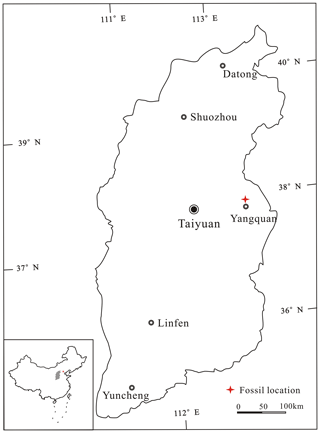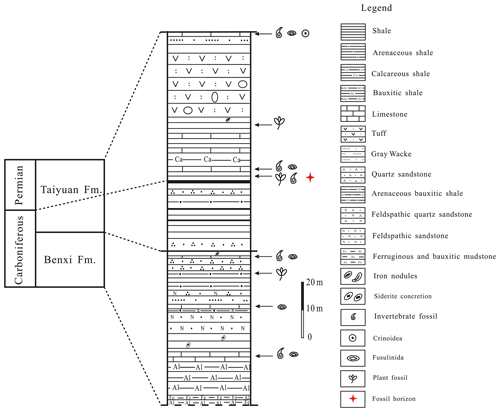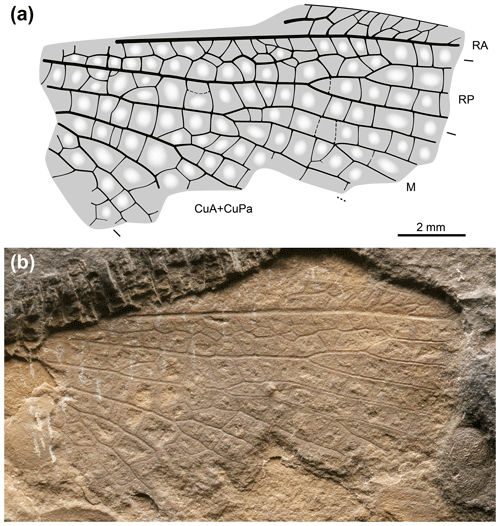Aristov, D. S.: Grylloblattids of the family Ideliidae (Insecta:
Grylloblattida) from the Lower Permian of the Ural Mountains, Paleontol. J.,
36, 44–47, 2002.
Béthoux, O.: Revision of Cacurgus Handlirsch, 1911, a basal Pennsylvanian
Archaeorthoptera (Insecta: Neoptera), B. Peabody Mus. Nat. Hi., 47, 29–35,
2006.
Béthoux, O. and Nel, A.: Venation pattern and revision of Orthoptera
sensu nov. and sister groups, Phylogeny of Palaeozoic and Mesozoic
Orthoptera sensu nov., Zootaxa, 96, 1–88, 2002.
Fan, B. H., Zhu, W. B., and He, X. L.: Early Early Permian brachiopod fauna
from Yangquan, Shanxi Province, Acta Palaeontol. Sin., 38, 353–364, 1999.
Gao, J. H.: The Paleoecological features and environment background of
brachiopod from the Taiyuan formation in Shanxi Province, Geoscience, 2,
175–185, 1988.
Ge, B. X., Yiu, G. X., and Li, Ch. Sh.: A Preliminary study on sedimentary
environments and law of coal- bearing formation in Yangquan, Shanxi, Acta
Sedimentol. Sin., 3, 33–44, 1985.
Handlirsch, A.: New Paleozoic insects from the vicinity of Mazon Creek,
Illinois, Am. J. Sci., 31, 297–326, 353–377, 1911.
Lameere, A.: Sur la nervation alaire des Insectes, B. Cl.
Sci. Ac. Roy. Bel., 8, 138–149, 1922.
Lameere, A.: On the wing-venation of insects, Psyche, 30, 123–132, 1923.
Linnaeus, C.: Systema naturæ per regna tria naturæ, secundum
classes, ordines, genera, species, cum characteribus, differentiis,
synonymis, locis, Stockholm, 824 pp., 1758.
Martynov, A. V.: On two basic types of insect wings and their significance
for the general classification of insects, in: Trudy Pervovo Vserossijskovo
S'exda Zoologov, Anatomov i Gistologov, edited by: Deryugina, K. M., Nauka,
Moscow, Russia, 88–89, 1923.
Storozhenko, S. Y.: Sistematika, filogeniya i evolyutsiya grilloblattidovykh
nasekomykh (Insecta: Grylloblattida), Dal'nauka, Vladivostok, 207 pp., 1998.
Wan, M. L., Yang, W., He, X. Zh, Liu, L. J., and Wang, J.: First record of
fossil basidiomycete clamp connections in cordaitalean stems from the
Asselian–Sakmarian (lower Permian) of Shanxi Province, North China,
Palaeogeogr. Palaeocl., 466, 353–360, 2017.
Wang, J.: Late Paleozoic macrofloral assemblages from Weibei Coalfield, with
reference to vegetational change through the Late Paleozoic Ice-age in the
North China Block, Int. J. Coal Geol., 83, 292–317, 2010.
Wu, X. Y.: Carboniferous floras, in: Fossil Floras of China Through the
Geological Ages, edited by: Li, X. X., Zhou, Z. Y., Cai, C. Y., Sun, G.,
Ouyang, S., and Deng, L. H., Guangdong Science and Technology Press, 58–93,
1995.
Zhang, H. X.: The late Paleozoic brachiopod communities and their
environmental significance from Shuiquangou, Yangquan, Shanxi Province,
Inner Mongolia Sci. Technol. & Econ., 1, 75–76, 2017.







